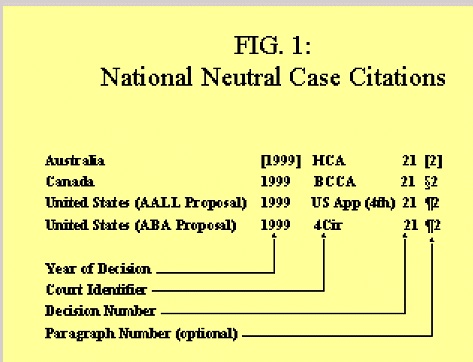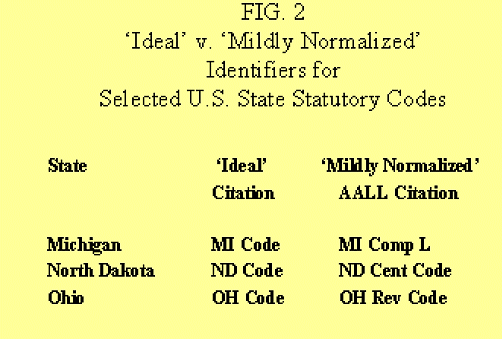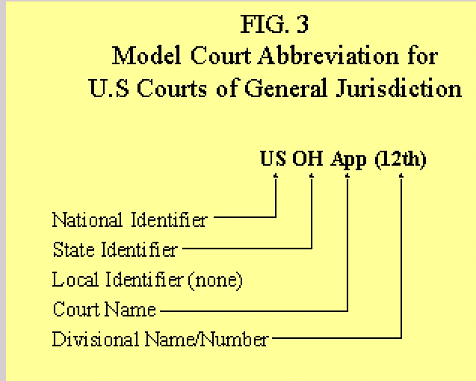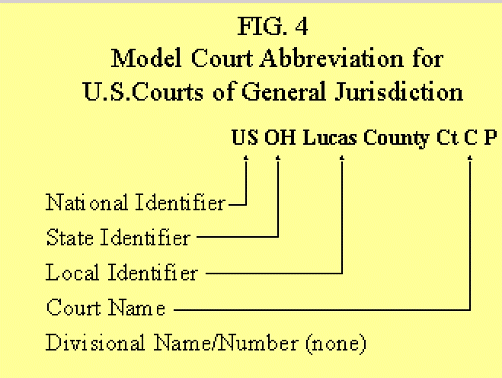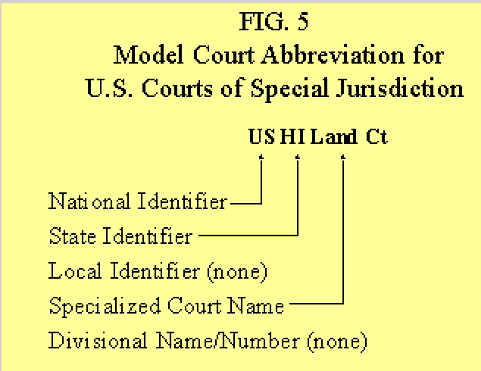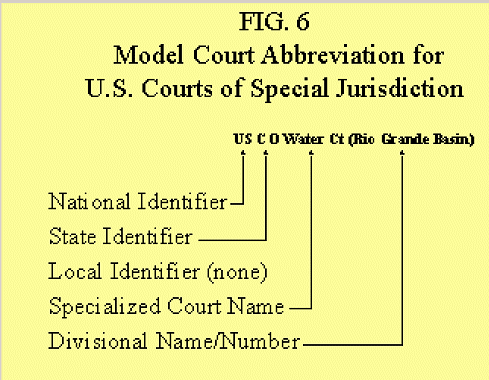JILT 2000 (3) - Bruce Kennedy
Figure 1: The similarity in structure of neutral case citations from three jurisdictions. This similarity is not accidental. Australian and Canadian reformers designed their citation standards with full awareness of citation reform initiatives in other nations.[ 3 ]. This suggests that international citation reform may occur through 'conscious parallelism' among nations. If this is so, an international citation reform organization can play an important role by synthesizing innovative national standards into broad, flexible global standards and encouraging all nations to converge around these global standards. Accordingly, this author believes that global neutral citation standards should be jointly developed by both international and national citation reform groups. The need for collaboration and accommodation between these two branches of citation reform is the focus of this commentary. In a national context, neutral citations should strive to meet four criteria. To the greatest extent possible, neutral citations should be: 1) medium neutral; 2) vendor neutral; 3) simple; and; 4) uniform within a jurisdiction. Medium neutrality means that the new citation rules must allow researchers to cite materials in any format, be it print or electronic. Vendor neutrality means that the citation data elements must lie in the public domain so that the citation system can be freely used by any publisher and all researchers. Simplicity means that neutral citations must be easily understood by the lay public as well as the legal fraternity. Uniformity means that similar documents should be cited according to a common pattern that is comprehensible to the national bar of the jurisdiction. In other words, individual states, provinces or departments within a nation should not use idiosyncratic citation forms that are mystical to all but the local legal community. These four criteria are no less important at the international level, although the fourth item, uniformity, will undoubtedly spark controversy. Some measure of uniformity, however, is essential to a successful international citation system. Ideally, international citations should be usable by any researcher anywhere. One should not need to be a Rechtsanwalt, or even German, to merely find a German Commercial Code provision, nor a solicitor, or English, to locate a Queen's Bench case. Global entrepreneurs and activists alike need a cross-cultural citation system to access relevant foreign law that bears on transnational problems and opportunities. An international citation system should be catholic - in the secular sense of the word. Exactly how rational or logical this international citation system can be depends upon how often and how far the system must depart from the canon of uniformity to accommodate the special needs of national legal cultures. Some accommodation is inevitable. Even an ideal international citation system would fail, and fail miserably, if the system cannot operate in harmony with national legal cultures. For the purpose of this study, 'national legal culture' is broadly defined. As used here, the term embraces the attitudes, behaviors, customs, ideas, institutions, opinions, norms, procedures, traditions and values related to the operation of a nation's legal system. In short, the term 'national legal culture' is a convenient label for the totality of the intellectual and operational features of a national legal system. Of course, this concept includes national traditions in legal publishing and citation practices. The ideal international neutral citation system for legal materials would be uniform over several dimensions. First, such a system would use standardized citation forms for each form of law. Standardized citations forms would be prepared for judicial opinions, session laws, codified statutes and all other types of legal authority. Each citation form would serve as an archetype for citing that type of legal document from any nation. For example, an international neutral case citation would serve as the archetype for citing judicial opinions from all nations. The merits of a standardized case citation are twofold. First, it lends coherence to an amazingly complex mass of national case law. Second it is consumer- friendly to researchers. With a casual glance at a standardized case citation, a researcher from any country can intuitively recognize a point of authority as a judicial case, even if the researcher knows little else about that nation's legal system. Moreover there is no inherent reason why Australian, Malaysian, South African, Italian, Canadian or Chilean cases should not be cited in the same format, even if the weight of case law as legal authority varies from jurisdiction to jurisdiction. Beyond standardized citation forms, the ideal system should also have standardized internal parts. Ideal international neutral legal citations should consist of: 1) uniform data elements; 2) featuring normalized identifiers for jurisdictions, tribunal names and publication names; 3) set in a uniform sequence with 4) a uniform presentational style. Can this ideal be achieved? Not completely. However, if national and international citation reformers collaborate, pragmatic citation standards can be drafted to avoid citation anarchy and minimize citation chaos. National sensitivities are pricked by citation reform because nations project their sovereignty into their law-making institutions and their legal literature. No international citation system can hope to gain general acceptance unless it operates in harmony with national legal institutions and literature. 3. Differences in the architecture of national legal literature First and foremost, international citation reform must accommodate the 'architecture' of each nation's legal literature. To illustrate this point, consider the differences between the legal literature of the United States and Germany. United States law is recorded in a relatively fragmented literature. Separate publications disseminate state and federal law and, at each level of government, separate publications disseminate case law, statutes and regulations. To access this decentralized literature, the AALL Citation Format Committee created standardized citation forms for judicial opinions,[ 4 ] session laws,[ 5 ] codified statutes,[ 6 ] constitutions [ 7 ] as well as regulations published within administrative codes [ 8 ] and administrative registers.[ 9 ] Conspicuously absent from the American legal literature, and so missing from American neutral citations, is the concept of an official gazette that amalgamates legislation with secondary legislation and other legal documents. Germany has a magnificent gazette, the Bundesgesetzblat . Theoretically citation reformers can devise standardized citation forms for all forms of law appearing in the German gazette, making it unnecessary to cite to the gazette. Almost certainly, however, Germany would reject such a collection of neutral citation forms as a replacement for the present ability to cite directly to its gazette. So citation reformers will need to craft a standardized citation form for an official gazette to accommodate German legal literature. Elsewhere around the world, citation reformers must be willing to create whatever new citation forms may be necessary to sustain the architecture of any nation's legal literature. 4. Nomenclature - mild normalization Nomenclature is another troublesome issue for international citation reform. Nations are justifiably proud of the names of their legal publications and law making institutions. Judges, legislators, lawyers and laymen object when citation reformers attempt to rename 'their' code or 'their' Supreme Court. Yet citation reformers, who would design a coherent, rational citation system, are predisposed to use normalized identifiers for a set of publications or a set of tribunals. Invariably some of these normalized identifiers conflict with local popular names. Figure 2 shows how this conflict can be ameliorated by the technique of 'mild normalization'.
Figure 2: The Mild Normalization technique Each state within the United States publishes a codified version of its statutes. Designing neutral citations for these codes could be simplified by using a normalized identifier consisting of a state abbreviation followed by the word 'Code'. Using this formula, the statutory codes for Michigan, Ohio and North Dakota could be known simply as 'MI Code', 'OH Code' and 'ND Code'. Unfortunately these codes already have different popular names - the Michigan Compiled Laws , the Ohio Revised Code and the North Dakota Century Code, and these varied code names translate into varied citation data elements. The AALL Citation Format Committee reasonably feared that local powers within these jurisdictions would reject fully normalized code names. So the Committee recommended 'mildly normalized' code identifiers consisting of the state abbreviation followed by a condensed version of each state's popular code name - e.g. 'MI Comp L', 'OH Rev Code' and 'ND Cent Code'. Even more difficult is the normalization of tribunal names. For the American statutory codes mentioned above, unfettered use of popular names results in no more than 50 distinctive publication identifiers, which some consider to be manageable chaos. However, the 50 American state judiciaries are so varied in their organization and operation, that uncontrolled use of popular names for courts would produce an incoherent mass of arbitrary tribunal identifiers. Normalized identifiers are much more important to impose order for tribunals than for publications. To cope with the amazing diversity among America's state and Federal courts, the AALL Citation Format Committee opted for an algorithmic approach to create unique court identifiers. An internationalized version of this approach is illustrated below in Figures 3 through 6. Figures 3 and 4 below present and dissect sample court abbreviations for two Ohio courts of general jurisdiction. Starting from the left side of the court abbreviation, the court abbreviation is composed of 1) a national identifier, 2) a state and local identifier - if needed, and then 3) an identifier for the name of the court - if needed. Then, if it is important to know the division which issued the opinion, the name or number of the division of the court appears in a parenthetical at the end of the court abbreviation. Using this algorithmic approach, it is possible to construct unambiguous court abbreviations for all American trial and appellate courts of general jurisdictions
Figure 3: Sample Court Abbreviation 1
Figure 4: Sample Court Abbreviation 2 American states have also created specialized courts - such as Tax Courts, or Courts of Claim - and sample citations for two of these specialized courts are shown in Figures 5 and 6.
Figure 5: Sample Citation 1
Figure 6: Sample citation 2 The sequence of identifiers is essentially the same as the general algorithm except that the specialized name of the court appears after the last geographic element. This approach can produce abbreviations for any specialized American court - from the Hawaiian Land Court to the Colorado Water Court. Some system of normalized identifiers for tribunals seems necessary if an international citation system is to cope with the thousands of entities that produce national case law. However, as was true of publication identifiers, conflict can be expected between supporters of international, normalized tribunal identifiers and partisans of existing, popular court abbreviations. Obviously conflict can be minimized if national citation reformers can participate enough in international reform to embrace the international pattern as their own. Also relenting on strict name normalization - perhaps employing the technique of 'mild normalization' noted above - may do much to placate national pride. Beyond issues of national literary architecture and normalized identifiers await a host of smaller citation design issues. Nations vary on the data elements to be included in a particular citation form, the sequence in which data elements should appear and the presentation of the data elements. So on the matter of a neutral case citation, nations may disagree on 1) whether the decision date should be a full date or just a year, 2) whether the date should appear at the beginning or end of the citation and 3) whether [square brackets] or (parentheses) should surround the date. These differences may influence the 'comfort-level' that researchers have with a neutral citation system and so may affect consumer acceptance. However dissention on these issues can be reduced by close cooperation between national and international reformers and according the public ample opportunity to comment on international citation proposals. Even with active consensus building, nations may insist on minor differences in national citation standards that will diminsh the coherence of a global citation system. Thus far, the discussion has focused on how international citation standards must accommodate the needs of national legal culture - but on at least one crucial matter reverse accommodation must occur. National accommodation must occur in the opposite direction concerning government legal publications that are not yet medium or vendor neutral. These national legal publications must be restructured before they can be incorporated into an international system of neutral citations. For example, American lawyers cite Federal regulations by reference to the Federal Register , which is currently not medium neutral since its content is organized into volumes and pages. Even if the American legal community wishes the world to cite this publication as the preferred source for Federal regulations, the world should not compromise its quest to establish a neutral system of citations. Reformers should not accept the source as it is currently structured. Instead national citation reformers - with international support - should propose that new data elements be embedded into the source to make it capable of neutral citation. While redesigning national legal literature is daunting, this is precisely how reformers in Australia, Canada and the United States rendered their case law amenable to neutral citation. Obviously, however, this restructuring must come from within the jurisdiction itself as an exercise of national citation reform. As the foregoing suggests, national culture 'matters' in the design of international neutral legal citations. If we could resurrect a single person to design an international system of neutral legal citations - the person best suited to the task is Solon. Other lawgivers, such as Hammurabi, Tribonis, Portalis or perhaps Jefferson, might produce a magnificent citation system of breathtaking rationality and simplicity. Solon, however, would not give us the best citation system he could devise, but the best citation system we would receive. Only with this attitude in mind, can a successful international citation system be designed for a world of sovereign nations. 1 . Concerning Australian neutral citation reform see, Paragraph Numbers in High Court of Australia Judgments and the use of "Medium Neutral" Citations, (visited May 12, 2000) < http://www.hcourt.gov.au/short.htm >. Regarding Canadian citation reform initiatives see Canadian Citation Committee (last modified May 4, 2000) < http://www.lexum.umontreal.ca/citation/en/index.html >. In the United States, two important neutral citation refom proposals have been sponsored by the American Association of Law Libraries (AALL) and the American Bar Association (ABA). For a description and discussion of the AALL Universal Case Citation, see American Association of Law Libraries, Task Force on Citation Formats, Report (1995), reprinted in 87 L. Libr. J. 577 (1995), available on the Internet at March 1, 1995 Report, AALL Task Force on Citation Formats (last modified March 22, 2000) < http://www.aallnet.org/committee/citation/>. For a description and discussion of the ABA Universal Case Citation see, Special Committee on Citation Issues, Report and Recommendation available on the Internet at ABA Legal Technology Resource Center (visited May 12, 2000) < http://www.abanet.org/citation/home.html >. 2 . See: Canadian Citation Committee, A Neutral Citation Standard for Case Law ¶ ¶ 42-43 (visited May 12, 2000) < http://www.lexum.umontreal.ca/citation/en/standard/standard.html#general >. 3 . Canada examined both Australian and American neutral citation proposals to frame a national case citation standard. See: Canadian Citation Committee, A Neutral Standard for Case Law, (visited May 12, 2000) < http://www.lexum.umontreal.ca/citation/en/standard/standard.html >at ¶ [2]. Australia studied the American Bar Association universal citation proposal before framing its neutral case citation. See: Council of Chief Justices of Australia and New Zealand, Electronic Appeals Project - Final Report: Appendix 12: An Overview of Medium Neutral Citations and Paragraph Numbering (visited Feb. 8, 2000) < http://www.ccj.org/reports/Appendix12.htm >. 4 . See AALL Committee on Citation Formats, Universal Citation Guide, Madison (WI): State Bar of Wisconsin Press, 1999 at ¶ 33 ( hereinafter Universal Citation Guide). 5 . Universal Citation Guide at ¶ 65. 6 . Universal Citation Guide at ¶64. 7 . Universal Citation Guide at ¶ 46. 8 . Universal Citation Guide. at ¶ 91. 9 . Universal Citation Guide at ¶ 92. |

